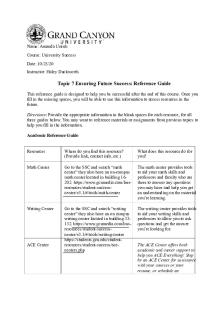COM 127 Reference Guide Template PDF

| Title | COM 127 Reference Guide Template |
|---|---|
| Course | Intro to Communication |
| Institution | Southern New Hampshire University |
| Pages | 2 |
| File Size | 78.3 KB |
| File Type | |
| Total Downloads | 94 |
| Total Views | 155 |
Summary
Completed reference guide...
Description
Communication Channels Reference Guide Name: Cameron Dunn Mass Media In Chapter 1 of Business Communication we learned that mass media, or mass communication, is the transmitting of messages to many people through print or electronic. There are many reasons a communicator would choose mass media as the channel to share their message. One reason being the potential reach of mass media. As technologies like the printing press advanced, from simple manuscripts to newspapers, storing and sharing their message became easier and easier. For an advertiser the more people you reach the more profitable you have potential to be, and that is done best through the mass media channel. Common Types 1. Internet a. E-mail and image hosting websites such as flicker, facebook, and youtube. 2. Television a. Cable news, informational programs and entertainment. 3. Cinema a. First mass media to combine audio and visual. Entertainment and propaganda. 4. Magazines a. Essays, current events and content regarding more important issues such as slavery and women’s right to vote. 5. Radio a. News like current events and weather, and broadcast music. Interpersonal Communication Interpersonal communication is the process in which messages are exchanged between two or more people face to face. A communicator would use an interpersonal channel to get a message out, but in a more specific way than a mass media channel would. In a situation where a presentation is being given the communication channel would be tailored more for the audience. The ability to communicate and build relationships is crucial to interpersonal communication. A communicator also has more control over emotional responses through this channel. Common Types 1. Oral communication a. Interviews and presentations. 2. Written communication a. E-mails, reports, performance evaluations. 3. Nonverbal communication a. Body language and active listening. Group Communication In chapter 3 of Business Communication we learn that Group communication is messages exchanged between members of a group. Often these members share a common goal or ideology. A communicator would use group communication to help develop and grow ideas. In the group setting
interaction and involvement between members of a group help the discussion develop. Group communication with a focus is an effective tool for a communicator. Common Types 1. Work teams a. Meetings, training, and feedback. 2. Sports teams a. Practice and strategy. 3. Friends a. Sharing information and entertainment. References Bisen, Vikram. Business Communication, New Age International Ltd, 2009. ProQuest Ebook Central, https://ebookcentral-proquest-com.ezproxy.snhu.edu/lib/snhu-ebooks/detail.action?docID=442132....
Similar Free PDFs

COM 127 Reference Guide Template
- 2 Pages

COM 127 Reference Guide
- 3 Pages

COM 127 Reference Guide
- 2 Pages

reference guide
- 2 Pages

Reference Guide
- 6 Pages

CHEM 127 Final Study Guide
- 5 Pages

Oscola quick reference guide
- 1 Pages

Reference-Guide-2017
- 73 Pages

UNV103-Reference Guide
- 4 Pages

Reference Guide-Trad Gingerichc
- 4 Pages

UNV Reference Guide
- 5 Pages

Soc-sociology reference guide
- 18 Pages

Topic 7 Reference Guide
- 6 Pages

UNV103 T7 Reference Guide
- 4 Pages

Reference Guide Completed
- 5 Pages
Popular Institutions
- Tinajero National High School - Annex
- Politeknik Caltex Riau
- Yokohama City University
- SGT University
- University of Al-Qadisiyah
- Divine Word College of Vigan
- Techniek College Rotterdam
- Universidade de Santiago
- Universiti Teknologi MARA Cawangan Johor Kampus Pasir Gudang
- Poltekkes Kemenkes Yogyakarta
- Baguio City National High School
- Colegio san marcos
- preparatoria uno
- Centro de Bachillerato Tecnológico Industrial y de Servicios No. 107
- Dalian Maritime University
- Quang Trung Secondary School
- Colegio Tecnológico en Informática
- Corporación Regional de Educación Superior
- Grupo CEDVA
- Dar Al Uloom University
- Centro de Estudios Preuniversitarios de la Universidad Nacional de Ingeniería
- 上智大学
- Aakash International School, Nuna Majara
- San Felipe Neri Catholic School
- Kang Chiao International School - New Taipei City
- Misamis Occidental National High School
- Institución Educativa Escuela Normal Juan Ladrilleros
- Kolehiyo ng Pantukan
- Batanes State College
- Instituto Continental
- Sekolah Menengah Kejuruan Kesehatan Kaltara (Tarakan)
- Colegio de La Inmaculada Concepcion - Cebu
